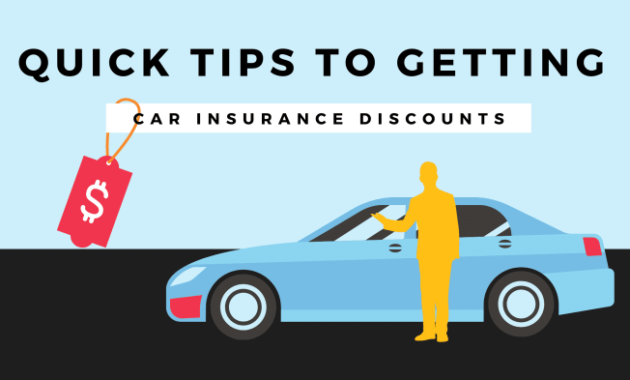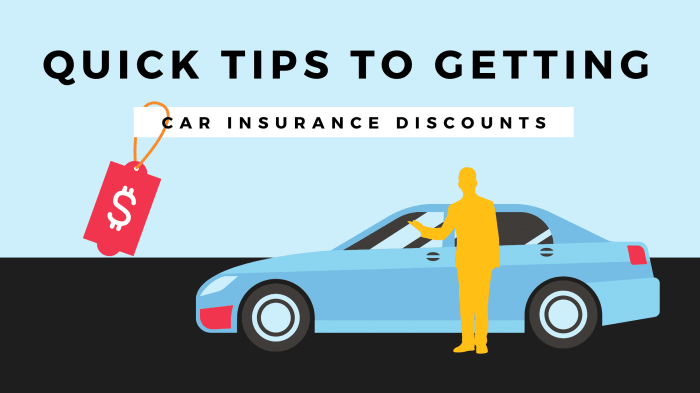
Navigating the world of car insurance can feel like driving through a maze, but understanding available discounts can significantly reduce your premiums. This guide illuminates the various avenues to lower your costs, from safe driving habits to bundling insurance policies, helping you find the best deals and keep more money in your pocket. We’ll explore the different types of discounts, eligibility requirements, and strategies to maximize your savings.
From leveraging your good driving record to taking advantage of vehicle safety features, we’ll examine a range of opportunities to decrease your annual insurance expenditure. We’ll also delve into the often-overlooked impact of factors like your credit score and the benefits of bundling your insurance policies for comprehensive cost savings.
Bundling Discounts

Bundling your insurance policies can lead to significant savings. By combining different types of insurance under one provider, you often qualify for discounts that wouldn’t be available if you purchased each policy separately. This is because insurance companies recognize the reduced risk associated with insuring multiple policies for a single customer. This streamlined approach simplifies administration and reduces their overall costs, which they pass on to you in the form of lower premiums.
Bundling offers a convenient and cost-effective way to manage your insurance needs. It simplifies your financial life by consolidating payments and providing a single point of contact for all your insurance-related inquiries.
Types of Insurance Suitable for Bundling
Several types of insurance are commonly bundled together for discounts. The specific options available may vary depending on your insurance provider, but common combinations often include home and auto insurance, as well as other policies such as motorcycle, boat, or even umbrella liability insurance.
Hypothetical Cost Savings Scenario
Let’s imagine Sarah, a homeowner and car owner. She currently pays $1,200 annually for her car insurance and $800 annually for her homeowner’s insurance with separate providers. If she bundles these policies with a single provider offering a 15% discount on bundled policies, her total annual premium would be significantly reduced. The combined initial cost is $2000. A 15% discount on this amount is $300. Therefore, her new annual cost would be $1700, resulting in annual savings of $300.
Bundling Advantages Infographic
The infographic would visually represent the benefits of bundling insurance policies. It would consist of four main sections, each with an illustrative icon and a short description.
* Section 1: Cost Savings: A graphic of stacked coins with a downward-pointing arrow. The text would read: “Reduce your overall insurance costs by up to 25% or more with bundled policies.”
* Section 2: Convenience: A graphic of a calendar with multiple checkmarks. The text would read: “Simplify your life with one easy payment and a single point of contact for all your insurance needs.”
* Section 3: Protection: A graphic of a shield. The text would read: “Comprehensive coverage across multiple assets, ensuring your valuable possessions are adequately protected.”
* Section 4: Peace of Mind: A graphic of a smiling face. The text would read: “Enjoy the peace of mind knowing you’re financially protected with comprehensive and affordable insurance.”
Discounts Based on Driving Habits

Many insurance companies now offer discounts based on your driving habits, recognizing that safer drivers pose a lower risk of accidents. This approach utilizes technology to monitor driving behavior and reward responsible driving with lower premiums. This system offers a fairer and more personalized pricing model compared to traditional methods that rely solely on demographic data.
Telematics devices and safe driving score calculations are key components of this system.
Telematics Devices and Their Impact on Insurance Premiums
Telematics devices, often small plug-in gadgets or smartphone apps, track various aspects of your driving. This data includes speed, acceleration, braking, mileage, time of day driving occurs, and even location. By analyzing this data, insurance companies can assess your driving style and identify risky behaviors. The more responsible your driving, as reflected in the data collected, the lower your insurance premium is likely to be. For example, consistently driving below the speed limit and avoiding harsh braking maneuvers would generally result in a better score and thus a larger discount. Conversely, frequent speeding or hard braking could lead to a higher premium.
Safe Driving Score Calculation and Discount Determination
Safe driving scores are calculated using algorithms that analyze the data collected by telematics devices. These algorithms weigh different driving behaviors differently. For instance, speeding might be weighted more heavily than harsh braking. The specific algorithm and weighting system vary between insurance providers. Once a score is calculated, it’s compared to a pre-determined scale to determine the discount amount. A higher score generally translates to a larger discount, sometimes up to 40% or more depending on the insurer and the individual’s driving record. Insurance companies often provide regular updates on your score and the associated discount, allowing you to monitor your progress and adjust your driving accordingly.
Comparison of Telematics Programs
Different insurance companies offer diverse telematics programs with varying features and reward structures. Some programs might focus solely on speed and braking, while others might incorporate factors like nighttime driving or mileage. Some programs offer immediate feedback on your driving, while others provide summaries at the end of a set period. The level of detail in the feedback and the size of the potential discounts also vary. For example, one company might offer a discount based on a simple score, while another might offer tiered discounts based on achieving certain milestones or maintaining a consistent safe driving record over an extended period.
Benefits and Drawbacks of Using a Telematics Device
Before deciding to participate in a telematics program, consider the potential benefits and drawbacks:
- Benefits: Potential for significant premium discounts, increased awareness of driving habits, opportunity to improve driving skills and reduce risk of accidents, personalized feedback on driving performance.
- Drawbacks: Privacy concerns regarding data collection, potential for inaccurate data recording, possibility of increased premiums if driving habits are deemed unsafe, reliance on technology and potential for device malfunctions.
Closing Summary

Securing the best car insurance rate involves a proactive approach. By understanding the various discounts available and tailoring your choices to your specific circumstances, you can significantly reduce your insurance costs. Remember to regularly review your policy and explore new opportunities to save. Armed with this knowledge, you can confidently navigate the insurance landscape and find the most affordable and suitable coverage for your needs.
FAQ Insights
How often should I review my car insurance policy for potential discounts?
It’s advisable to review your policy at least annually, or whenever you experience a significant life change (e.g., marriage, new car, change in driving habits).
Can I get a discount if I’ve taken a defensive driving course?
Many insurers offer discounts for completing approved defensive driving courses. Check with your provider for details.
What if I have a lapse in my car insurance coverage? Will it affect my ability to get discounts?
A lapse in coverage can negatively impact your ability to secure discounts. Continuous coverage is generally preferred by insurers.
Do all insurance companies offer the same discounts?
No, discount offerings vary significantly between insurance companies. Comparing quotes from multiple providers is essential.